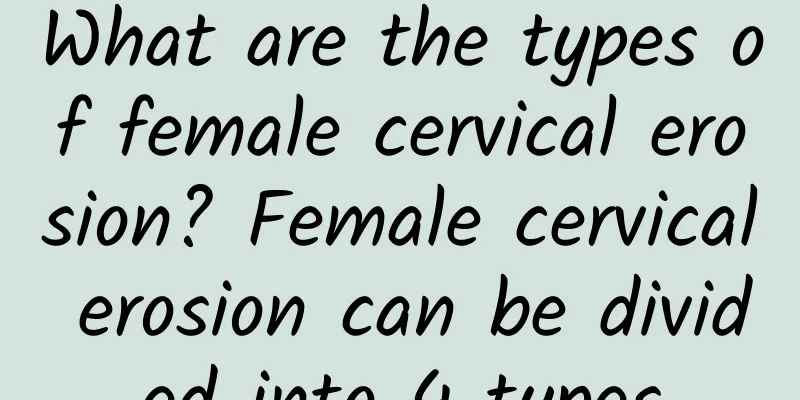What are the types of female cervical erosion? Female cervical erosion can be divided into 4 types

|
In life, cervical erosion is a complex disease that is common among women. Pathologically, there are two types of cervical erosion: true erosion and false erosion. In clinical work, many patients' symptoms are mostly false erosion. But in fact, according to the severity, symptoms and causes of the disease, the types of cervical erosion are more diverse. So, how many types of cervical erosion can be divided into? 1. Fungal cervical erosion This type of cervical erosion is also called Candida cervical erosion. It is a type with a relatively high incidence rate. The main symptoms are increased leucorrhea, which is often curd-like or lumpy. The vagina and vaginal vestibule mucosa are highly edematous and covered with a white curd-like film, which is distributed in dots or sheets and is easy to peel off. Underneath is a damaged flushing base, or ulcers are formed, and ecchymosis may also be left. In severe cases, the labia minora may swell and adhere. In addition, there are symptoms such as burning and itching of the vulva and vagina. If the urethra is affected, there will be symptoms of frequent urination, urgency, and pain when urinating. 2. Trichomonas cervical erosion What are the types of cervical erosion? The main symptom of trichomoniasis cervical erosion is also an increase in leucorrhea, and the leucorrhea is thin and serous, and can also be grayish yellow or yellow-green, sometimes mixed with blood. About 20% of women have foam in their leucorrhea. Vulvar itching, burning, and sexual intercourse pain are also common. If the infection involves the urethra, there will be symptoms of urinary pain, urgency, and even hematuria. 3. Bacterial cervical erosion Clinical studies have found that about 10% to 50% of bacterial cervical erosion has no symptoms. Even if there are symptoms, there is an increase in abnormal vaginal secretions, which are thin, homogeneous or thin, pasty, grayish white, grayish yellow or milky yellow, with a fishy odor, and there may also be a burning sensation in the vagina. 4. Nonspecific cervical erosion The main symptom of nonspecific cervical erosion is usually an increase in vaginal discharge, which may be purulent or serous, and in severe cases, may have a foul odor. The discharge irritates the urethra, causing urinary urgency, pain, a sense of falling in the vagina, burning sensation, pelvic dysfunction, and general fatigue. Warm reminder: I hope everyone can understand the symptoms and characteristics of cervical erosion as soon as possible, effectively maintain health, and pay attention to reasonable treatment and effective diagnosis to avoid serious illness. At the same time, you should also pay attention to care and a reasonable diet. You should pay attention to your daily life and pay attention to your hygiene in daily life. |
>>: Why do married women suffer from cervicitis? How can married women prevent cervicitis?
Recommend
What causes women to develop cervical precancer?
If cervical erosion is not treated for a long tim...
Ovarian cyst pain symptoms
Ovarian cyst pain symptoms: Ovarian tumors are co...
What are the symptoms of uterine cysts?
What are the symptoms of uterine cysts? 1. Lower ...
Six precautions for preventing Trichomonas vaginitis
"What are the methods to prevent Trichomonas...
What should I eat to replenish my body after a miscarriage in four months of pregnancy
After a miscarriage, you need to help your body r...
Eating ice to cool down and reduce fever may aggravate inflammation in the body! 5 dietary tips to reduce heat and relieve summer heat
Although it is already the beginning of autumn, t...
What is the best treatment for uterine fibroids?
There is generally no optimal treatment for uteri...
Experts explain physical therapy methods for treating cervical hypertrophy
Cervical hypertrophy is a common gynecological di...
Causes of pelvic inflammatory disease in unmarried women
Pelvic inflammatory disease is a disease that fem...
The hazards of painless abortion are manifested in the following aspects
Painless abortion is very harmful to women. Women...
What is the impact of cervical hypertrophy on sexual life? What are the ways to prevent cervical hypertrophy?
Clinically, if cervical hypertrophy is not well p...
Understand the detailed points of painless abortion precautions
Painless abortion is very harmful to our female c...
What are the symptoms of a female abortion that is not done cleanly? Three things to pay attention to after a female abortion
During an abortion, if the fluid is not discharge...
What is painless abortion and what types of painless abortion surgeries are there?
Due to some problems, some mothers may not be abl...
The legs are firmer! 2 Steps to Stretch Front Thigh
Sitting, standing or walking for a long time can ...









